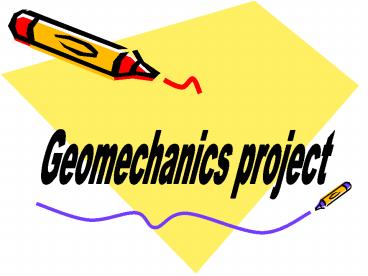Geomechanics project - PowerPoint PPT Presentation
1 / 24
Title:
Geomechanics project
Description:
Stress, defined as force per unit area, is a measure of the intensity of ... state railways, designing some famous bridges and making some of the earliest ... – PowerPoint PPT presentation
Number of Views:174
Avg rating:3.0/5.0
Title: Geomechanics project
1
Geomechanics project
2
- Stress
- Stress tensor
- Principal stresses and directions
- Maximum shear stresses and directions
- Failure theories
3
- Stress
4
- Stress, defined as force per unit area, is a
measure of the intensity of internal forces
acting within a body across imaginary internal
surfaces, as a reaction to external applied
forces and body forces. - Stress is often broken down into its shear and
normal components as these have unique physical
significance. - Stress is to force as strain is to deformation.
5
(No Transcript)
6
- Stress tensor
7
- Stress is a second-order tensor with nine
components, but can be fully described with six
components due to symmetry in the absence of body
moments. - In N dimensions, the stress tensor ?ij is
defined by
8
- The transformation relations for a second-order
tensor like stress are different from those of a
first-order tensor, which is why it is misleading
to speak of the stress 'vector'. Mohr's circle
method is a graphical method for performing
stress (or strain) transformations.
9
- Principal Stresses and Directions
- Maximum Shear Stresses and Directions
- Failure Theories
10
- Failure Theories
- This section uses the functionality in Structural
Mechanics to consider three fundamental failure
criteria - maximum normal stress theory
- maximum shear stress theory
- distortion energy theory
11
- Stresses in dimensional bodies
- All real objects occupy three-dimensional space.
However, if two dimensions are very large or very
small compared to the others, the object may be
modelled as one-dimensional.
12
- For one-dimensional objects, the stress tensor
has only one component and is indistinguishable
from a scalar. The simplest definition of stress,
s F/A, where A is the initial cross-sectional
area prior to the application of the load, is
called engineering stress or nominal stress. - In one dimension, conversion between true stress
and nominal (engineering) stress is given by - strue (1 ee)(se)
- The relationship between true strain and
engineering strain is given by - etrue ln(1 ee).
13
Stress in two-dimensional bodies
- Augustin Louis Cauchy was the first to
demonstrate that at a given point, it is always
possible to locate two orthogonal planes in which
the shear stress vanishes. These planes in which
the normal forces are acting are called the
principal planes, while the normal stresses on
these planes are the principal stresses.
14
- The two dimensional Cauchy stress tensor is
defined as - Then principal stresses s1,s2 are equal to
- Mohr's circle is a graphical method of extracting
the principal stresses in a 2-dimensional stress
state. The maximum and minimum principal stresses
are the maximum and minimum possible values of
the normal stresses.
15
Stress in three dimensional bodies
- the stress has two directional components one
for force and one for plane orientation in three
dimensions these can be two forces within the
plane of the area A, the shear components, and
one force perpendicular to A, the normal
component. - This gives rise to three total stress components
acting on this plane.
16
- Mohr's circle
- Christian Otto Mohrs life
17
Mohr's life
- Christian Otto Mohr (October 8, 1835 - October 2,
1918) was a German civil engineer, one of the
most celebrated of the nineteenth century. - Starting in 1855, his early working life was
spent in railroad engineering for the Hanover and
Oldenburg state railways, designing some famous
bridges and making some of the earliest uses of
steel trusses.
18
- Mohr was an enthusiast for graphical tools and
developed the method, for visually representing
stress in three dimensions, previously proposed
by Carl Culmann. - In 1882, he famously developed the graphical
method for analysing stress known as Mohr's
circle and used it to propose an early theory of
strength based on shear stress.
19
Mohr's circle
- Mohr's circles provide a planar representation
of a three-dimensional stress state. Mohr's
circle may also be applied to three-dimensional
stress. In this case, the diagram has three
circles, two within a third.
20
- Vertical and horizontal concentrated force on the
surface of the half-space
21
Vertical concentrated force on the surface of
half space
22
- . On account of symmetry, the displacement of the
point N in picture is defined by two components - w (r, z) the vertical displacement of the
point N - u r (r, z) the horizontal radial displacement
of the point N
23
- The line load p?, acting on the surface of a
half space, can be divided in an infinite
number of elementary forces p? dy. Since it is
assumed that the soil mass is ideally elastic,
the resultant produced by force p? dy
24
Horizontal line load of infinite length on the
surface of half space
- The problem of determination of stresses and
displacements produced by a concentrated
horizontal load acting on the surface of a half
space was studied by Cerruti (1882).































